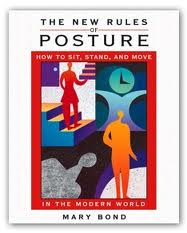The New Rules of Posture

Many people cause their own back and body pain through their everyday bad postural and movement habits. Many sense that their poor posture is probably the root of the problem, but they are unable to change long-standing habits.
In The New Rules of Posture book, Mary Bond approaches postural changes from the inside out. She explains that healthy posture comes from a new sense we can learn to feel, not by training our muscles into an ideal shape. Bond identifies the key anatomical features that impact alignment, particularly in light of our modern sedentary lives, and proposes six zones that help create postural changes: the pelvic floor, the breathing muscles, the abdomen, the hands, the feet and the head. She offers self-help exercises that enable healthy function in each zone as well as information on basic ergonomics and case histories to inspire us to think bout our own habitual movements.
- This book is awesome. She explains posture as a result of movement, not statically sitting and standing, and she gives simple exercises that address your connective and supportive tissues from your feet all the way up to your head. Problems I've had for years are melting away as I follow her suggestions!
Michelle - published on Goodreads.com
- The New Rules of Posture: How to Sit, Stand, and Move by Mary Bond is a must read if you're interested in increasing your somatic awareness of your body in motion. Hoorah! finally someone writes about the body as a moving entity and not as a stable unit moving just one joint at a time. Posture for Bond is not about standing still and sticking your chest out, but about how you move is number one of the new rules. Bond writes, "your posture is the product of the ongoing perceptual activities through which you orient yourself to your world." Bond's goal is to make readers more aware of opening the body up to the world. The entire book focuses on the action of walking to gain an understanding of what Bond calls open stabilization and open orientation. These terms of Bond's encourage movement without unnecessarily tensing muscles in the body that over time develops fascial adhesions and ultimately leads to restricted movement and decreased range of motion. Fascial adhesions where two or more fascia stick together can occur in a variety of locations because fascia, the connective tissue in the body, is everywhere. In fact Bond writes that if everything in our bodies were taken away fascia would maintain a recognizable human form. Things can get pretty complicated when posture is theorized as dynamic, but Bond is clear and precise. She divides her book into four sections: awareness, stability, orientation, and motion. Each section builds on the next. Threaded through each section are Bond's six zones of the body: breathing muscles, abdomen, pelvic floor, hands, feet and head. Bond states that all six regions are connected anatomically and unnecessary tension in any one of them causes a reaction in all of them. To help guide the reader to change bodily habits, Bond uses explorations throughout the book. For example she writes, "stand comfortably as though you are waiting in line for movie tickets. Then take a step forward toward the ticket window. Notice which leg took the step." In this exploration entitled, "your best foot" Bond's point is that because the spine accommodates the habits you have with your legs, if you have a strong preference for one leg over the other it could cause misalignment all the way up to your jaw. Throughout the book are fascinating facts and relationships in the body that if nothing else will help you to reconceive of your bodily connections. For example, Bond writes losing too much carbon dioxide by breathing too quickly can cause everything from depression to low back pain; she cautions against tightening the sacrum because it prevents your feet from meeting the ground successfully; and ,warns against performing the same movement over and over again. Why? Because repetition without staying aware of bodily signals diminishes our consciousness. All in all The New Rules of Posture enhances our consciousness and is a book to go back to again and again each time with a deeper understanding of the moving body.
Cynthia Roses-Thema, Ph.D - Published on Amazon.com
Site designed by Release-Remedial Therapies© | Login

We'd love to hear your reaction
Send Cancel